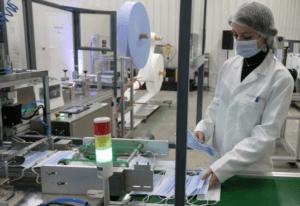Indonesia’s shipping and logistics industry is a hotbed for digital innovation. The country’s 17,500 islands and 300 million digitally connected consumers put incredible pressure on companies to move more products faster to meet demand. At the same time, they are dealing with COVID-related pressures, including soaring demand, port bottlenecks, labor disputes, and shifting rules around how products have to be packaged, handled, tracked, and shipped.
It’s an interesting time for the local shipping industry, which is made up of predominantly small and mid-sized local companies with little consolidation among players.

While many companies are struggling to stay afloat, some see this environment as an opportunity to reinvent the way products move through the country by using digital technology and customer data to become faster, leaner and more adaptable to the changing needs of customers. That includes finding new ways to address demand for direct-to-consumer delivery, which escalated quickly as the country struggled to accommodate safe and easy access to goods.
However, they need partners to help them build these digital transformation business models, and to figure out how to align their current business challenges with new market realities.
Digital partnership
These challenges have inspired new collaborations between logistics companies and digital firms, who are working together to accelerate the digital transformation journey. Digital transformation partnerships help companies alleviate the challenge and risk associated with co-creating new values, new business models, and new opportunities for sustainability.
These partnerships are about more than just deploying stand-alone technologies to solve individual issues. Digital transformation is really about people, and how to use data, smart technology and analytics to create exceptional experiences for employees, customers and the customers’ customers.
The technology is the tool to make these experiences possible. When companies approach digital transformation through the lens of human experience, it drives better results. When logistics companies partner with digital firms that understand the marketplace, they can reimagine how they move goods between ports, deliver goods directly to consumers, and how they can leverage eCommerce and digital transactions to drive efficiencies and meet demand.
4 best practices for digital transformation
Through our recent strategic partnership, Meratus Group and Schneider Electric teams have identified four priorities to make the most of this digital transformation journey.
1. Use data to create amazing customer experiences
Consumers companies, like Amazon, use customer data to predict what customers want before they want it, and to consistently exceed their expectations for quality and rapid delivery. Those customers are bringing the same expectations to their B2B experiences. The good news is that logistics and shipping companies already have all the data they need to create amazing customer experiences. But they need the technology and analytics expertise to transform that data into actionable insights. That’s where partnerships with digital experts can help them close the gap.
Digital partners bring fresh eyes and new ideas to the shipping industry, helping companies uncover hidden opportunities in their data, deploy analytics technologies to drive new business strategies and exceed customer expectations. For example, honing delivery routes to customers’ exact delivery time requests, using weather data to time deliveries, and leveraging hyperlocal delivery teams for last-mile services. When shipping companies work with digital experts, they can transform their raw data into insights that can help them reinvent the industry.
2. Innovate at the edges
Digital transformation requires the ability to try new ideas, fail fast, and quickly pivot to new solutions. Most big organizations struggle to embrace this kind of agility, but it can be enabled when companies create stand-alone groups that work at the edges of the organization. These self-contained teams aren’t held to formal KPIs and red tape, which frees them to think about what the future could look like, and to incubate bold ideas away from the mainstream.
This lean approach to innovation can help big companies innovate like a start-up, and determine which big ideas have merit before deploying them across the organization.
3. Treat data as a tool, not a solution
When logistics companies implement data analytics technology, they can uncover hidden insights that drive better business results. However, these insights won’t just emerge from a data set fully formed.
It starts with asking the right questions based on what you want to achieve and leveraging smart technologies, including artificial intelligence and machine learning to find relevant information in the sea of data.
If, for example, a company wants to reduce the time and cost of delivery they might ask how long are our containers delayed at ports, and at what points in the day or month do those delays peak? Or what percentage of our customers are in a specific community, and what can we do to combine shipments to shorten delivery times and lower gas costs?
When companies figure out which questions they want to answer, and build algorithms to search for insights, they can transform raw data into actionable insights, and drive decisions based on facts.
4. Leadership has to be the digital champions
Digital transformation can be painful. It requires companies to tear down siloes, employees to learn new skills, and managers to question long-held beliefs about how the company should operate. None of it will work if leaders aren’t driving the change. No matter how good your technology is, employees will also need a change management plan driven by leaders who communicate why change is happening, provide training and guidance to help employees adapt, and encourage early adopters to promote the benefits across the company.
Find partners who can accelerate your digital transformation
Digital partnership means going beyond the transactional behavior of the conventional ‘customer-supplier’ model. It’s about aligning around shared goals to improve efficiency, sustainability, and customer experience.
To achieve that synergy, companies need to find partners who share their broader business goal of improving every customer interaction and have the technological and industry expertise to help them make that happen. The right digital partner will enable a continuous co-creation model that aligns digital transformation to innovations in the customer experience, operations performance, and sustainability strategy. This is how digital transformation will disrupt the shipping and logistics industry and allow companies to continuously reinvent the business for a more resilient future.
Digital transformation in shipping and logistics is picking up speed. Those companies that accelerate their efforts and engage with partners to help them navigate this change have an opportunity to gain an edge in the marketplace. It won’t just make their business more resilient, it can help them deliver delightful customer experiences with a lighter impact on the environment.
For more information
Read this blog in Bahasa on CNN Indonesia.
To learn more about digital transformation, read Rik de Smet’s blog series. To jumpstart your business transformation journey, contact Schneider Electric Business Transformation Consultant Rik De Smet.




